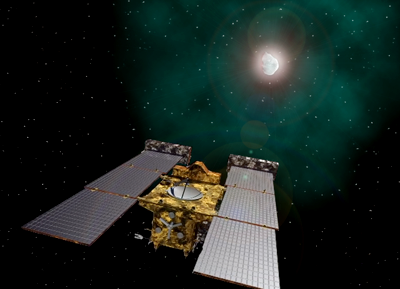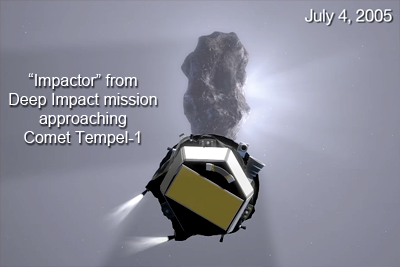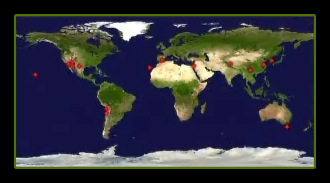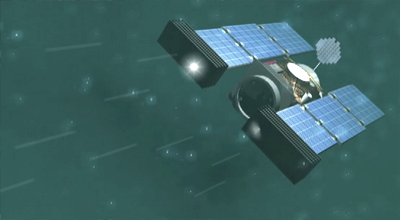On Monday 14 February 2011, the Spacecraft Stardust-NExT will encounter Comet Tempel-1, a historical meeting with this comet after a first encounter in 2005.

Scientists believe that the elements that started life on Earth arrived in comets, which are thought to contain water ice, dust and carbon-based compounds. Obtaining further evidence of the presence of these substances directly from a comet in space would strongly support that theory (Yeomans 2008).
Comet Tempel-1 was the subject of mission “Deep Impact” in 2005. In that occasion, an “Impactor” was deployed aiming to strike the comet. As the impactor approached its target, it took close-up pictures of the surface. The cameras of spaceship Deep Impact recorded the collision from a safe distance. The comet continued its trajectory towards the sun.
This time, Stardust-NExT will approach Tempel-1 on its way back from its orbit around the sun hoping to observe changes that might have occurred since 2005, including the man-made crater created by the hit of Deep Impact’s mission.

Stardust was launched by NASA in 1999 and so far it has travelled 5.6million kilometres. Three years after leaving Earth, the spacecraft flew close to Asteroid Annefrank, obtaining valuable data. In 2006 it approached Comet Wild 2 and captured samples of particles shed in its coma. When the spacecraft was close to Earth, it sent those samples in a capsule that landed safely and became a historical landmark; that was the first time scientists examined elements captured from a comet in space.
Late in 2009, the course of Stardust was corrected to target a flyby meeting with Tempel-1. According to plan, one hour before the meeting, the spacecraft will use its camera to target the brightness of the comet and re-align itself automatically. Due to the location of the encounter, at a distance similar to that from Earth to the Sun but on the other side of our star, communications with Stardust take around 40 minutes to arrive to Earth. This delay, together with the limited amount of fuel, makes controlling the mission a real challenge.
This is also the first time a comet is approached by a spacecraft on a second occasion; an invaluable opportunity to obtain new images and study the comet’s coma. Images are expected to arrive to NASA in 2 hours and become available in 12 hours, the time required for processing (JPL, 2011).



Many observatories around the world collaborated in the calculation of the trajectory of the comet. Their findings showed that Tempel-1 is gradually accelerating and probably rotating. Hopefully the calculations will be correct and the meeting will happen despite unpredictable changes of the course of the comet.
WAITING FOR THE BIG MOMENT
 Many observatories around the world collaborated in the calculation of the trajectory of the comet. Their findings showed that Tempel-1 is gradually accelerating and probably rotating.
Many observatories around the world collaborated in the calculation of the trajectory of the comet. Their findings showed that Tempel-1 is gradually accelerating and probably rotating.
Along its elliptical orbit around the Sun, the comet sheds particles that form its coma. These particles travel at very high speeds (approximately 6km/sec) becoming dangerous projectiles for any object that happens to be on their way.
 Stardust was built with a set of protective shields, which proved to be effective during its encounter with Comet Wild-2 in 2004. The image shows an artistic impression of particles hitting the shields. As the model shows, the protection is located at one end of the spaceship; this means that alignment parallel to the trajectory of particles is crucial for the survival of the instruments. It also means that most instruments cannot “see” directly into the comet while it is travelling across the coma.
Stardust was built with a set of protective shields, which proved to be effective during its encounter with Comet Wild-2 in 2004. The image shows an artistic impression of particles hitting the shields. As the model shows, the protection is located at one end of the spaceship; this means that alignment parallel to the trajectory of particles is crucial for the survival of the instruments. It also means that most instruments cannot “see” directly into the comet while it is travelling across the coma.
Despite the risks, the historical mission went ahead and on the night of St. Valentine’s day (14 February 2011), events unfolded as planned. The Space Agency shared the moments with the world via NASA-TV in a live broadcast from mission control in Denver, Colorado (Spacevidcast, 2011).
Below is the list of tasks carried out by Stardust as it crossed the path of comet Tempel-1. A night charged with emotion and expectations that finally brought a smile of satisfaction to everyone, those directly involved in the mission and millions of followers around the world.


References
¤ Live broadcast of Stardust meeting Tempel-1 (2011). Spacevidcast - NASA- JPL [Online]. Available here. (Accessed: 14 February 2011).¤ “Stardust-NExT: Encounter of Tempel-1, February 14, 2011” (2011). NASA-- Jet Propulsion Laboratory [Online]. Available here. (Accessed: 13 Feb. 2011).
¤ Yeomans, D. (2008). Why Study comets? NASA - Jet Propulsion Laboratory [Online]. Available here. (Accessed: 13 Feb. 2011).
No comments:
Post a Comment